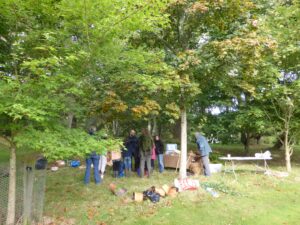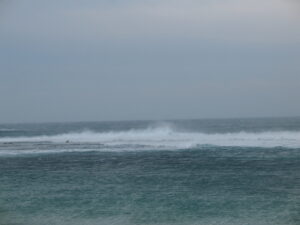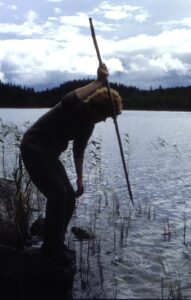
I’ve always been keen to promote archaeology to a wide audience. As such one can only be happy to see archaeological material being presented in a variety of popular media such as television, books and radio.
How sad, therefore, to hear a popular account of archaeology on Start the Week on Radio Four this week that was very misleading. My problems relate to the description of Britain in 9700 BC and thereabouts: Northern Britain under glaciers; tundra to the south and a landscape devoid of human settlement; Doggerland as a landbridge; the characterisation of the Scottish coast by raised beaches; and, of course, the tsunami that cut us off from the continent. Apart from the tsunami, it all sounded very drab. Of course, it pressed all my buttons for it is a period about which I feel passionately.
Most of my complaints relate to language and I know that makes me pedantic. But we are talking radio here, if language is not important then what is. To say that northern Britain was under glaciers in 9700 BC may be technically correct (though they were diminishing) but these were the re-advancing ice coverage of the Younger Dryas (sometimes known in Scotland as the Loch Lomond Stadial) and are more commonly referred to as ‘small ice caps’, rather than the full blown glacial cover. Similarly, to talk about the coastline of Scotland as characterised by post-glacial raised beaches is a gross over-simplification that owes more to the school books of my childhood than to current research. There are places, like Orkney, where the post-glacial coastline is characterised by the submergence of landscape.
To hear Doggerland described as an isthmus, a landbridge, or a plain always upsets me. The area of Doggerland in the Early Holocene is still based on fairly general models, but even these suggest that it was a considerable landmass. It is likely to have been bigger than several of the smaller European countries today, including England. I don’t think that is an isthmus. Low-lying plains? I do accept that on a chat show one does not have time to explore the nuances of current archaeological research. But the work on Doggerland is hardly new and shows clearly that it comprised rather more than the undulating landscape I caught in my mind’s eye as I listened. There are many people working on Doggerland and they include artists interested in ‘re-naming’ it as well as geoscientists interested in ‘re-wilding’ it. No one, perhaps, has done more than Vince Gaffney and his team to highlight the glories of Doggerland and its topography: lakes; hills; rivers; marshes, it is all there and now they are working to elucidate the animals and vegetation. Maybe it is just me, but I don’t see Doggerland as a landbridge, I see it as a country. For me Doggerland is exciting, full of promise, and a glimpse to a past where Britain takes its rightful place as a part of Europe.
Britain abandoned: the human occupation of Britain has a long and venerable history going back almost a million years and, yes, there are times when it is thought that people may have been absent. But not in recent times, and for me that includes anything from fifteen thousand years ago. Sites may be few and far between, but they are there. The last ‘Upper Palaeolithic’ hunters based their stone tool assemblages on long blades, and we are beginning to recognise related industries from sites across Britain from north-west Scotland and Orkney to, of course, the south. Scientific dates are still sometimes elusive but, where they are lacking, fairly accurate parallels may be drawn on the basis of dated sites elsewhere and these show good evidence for long-blade based activity in England by 11,500 BC and in Scotland around 11,000 BC. By 9000 BC things are really taking off: there is, for example, evidence of the sophisticated use of the landscape of the Vale of Pickering in Yorkshire with people at sites like Star Carr building houses and platforms and making use of those wonderful deer masks in hunting and other rituals. For me this is an exciting time: small groups are making their way in a rich landscape. Their culture is rich with meaning and possibility, building on a venerable ancestry to make the most of the world they encounter.
The power of the tsunami. Yes, of course, the Storegga Slide and associated tsunami were powerful events, transforming and treacherous for those who got in their path. But, the modelling that suggested (a while ago now) that the tsunami had washed away the last vestiges of Doggerland, was very generalised and simply showed that low lying coastal land would have been vulnerable. It is hardly rocket science. In reality, Doggerland had been diminishing for millennia before that. The tsunami provides a convenient shorthand for the loss of Doggerland, but I suspect that its real power lies among modern archaeologists rather than the people of the past. The population of Doggerland had a high degree of mobility, many were seafarers, all understood the landscape and held the inherent flexibility they needed to survive. They lived in a changing world; for them, change was the norm and they knew how to survive. The tsunami was a disaster, but Doggerland was already disappearing and would have been lost with or without the Storegga Slide. For me the tsunami is a distraction: I try to avoid it in lectures, but, usually, the first question will be along the lines of: ‘you didn’t mention the tsunami, but…’. Arghhh.
The final point to be made was that the geography of Britain, and the geographical processes to which the land is subject, make it inevitable that the south, specifically the south-east, should be the centre of things. It would be easy to think this, if the archaeology did not suggest otherwise. There is no evidence for any geographical ‘preferencing’ prior to around 3500 BC, except to say that populations in the north seem to have had their own roots and these roots may not always have been the same as those of the populations in the south. By 3500 BC the economic basis of life across Britain has shifted to farming and, curiously, current evidence suggests that something happens in the north to springboard a series of developments in cultural and social life which spread, pretty quickly, southwards. So the north had it first. Some might see this influence as culminating in the construction of monuments like Avebury and Stonehenge. Only after this do we begin to see the increasing social power of the south and it is a long time before it extends fully to encompass the north. My own hunch is that this power shift is related, among other things, to the increasing importance of external contacts and the way in which the proximity (and ease of access) to the continent allowed society in the south to develop.
For me the programme was interesting. It clearly got me thinking, and it is good to hear archaeology ‘out there’, but the content was sadly old fashioned. I can’t be the only one to find the period fascinating. The number of research projects taking place and pushing knowledge forward suggests that I’m not. There is new stuff to read, and it is always worth reading it.
Maybe the guests were just having a bad morning on Radio Four on Monday, but I was sad to hear them painting such a depressing view of our ancestors and the world in which they lived. It is a shame when popular science is out of date. If we are going to do it, we need to do it properly. I do understand that I’m biased, but for me the landscape of Doggerland and the lives of the Late Glacial and Early Mesolithic communities of Britain are full of wonderful, colourful, promise.



You must be logged in to post a comment.